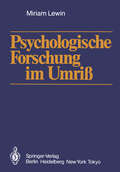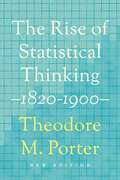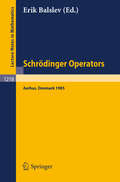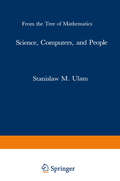- Table View
- List View
Post & Telecommunications (Reviews of UK Statistical Sources (RUKSS))
by S. Wall P. NicholsonThe review describes the publicly available sources of statistical information about postal and telecommunications in the United Kingdom. It covers public letter and parcel mail, postal orders, telephone, telegraph, telex, data and facsmile services. Given the 1981 Post Office reorganisation and the 1984 privatisation of British Telecom, this volume should prove a valuable resource to researchers and professionals requiring a guide to information in this rapidly changing field.
Potential Theory: An Analytic and Probabilistic Approach to Balayage (Universitext)
by Jürgen Bliedtner Wolfhard HansenDuring the last thirty years potential theory has undergone a rapid development, much of which can still only be found in the original papers. This book deals with one part of this development, and has two aims. The first is to give a comprehensive account of the close connection between analytic and probabilistic potential theory with the notion of a balayage space appearing as a natural link. The second aim is to demonstrate the fundamental importance of this concept by using it to give a straight presentation of balayage theory which in turn is then applied to the Dirichlet problem. We have considered it to be beyond the scope of this book to treat further topics such as duality, ideal boundary and integral representation, energy and Dirichlet forms. The subject matter of this book originates in the relation between classical potential theory and the theory of Brownian motion. Both theories are linked with the Laplace operator. However, the deep connection between these two theories was first revealed in the papers of S. KAKUTANI [1], [2], [3], M. KAC [1] and J. L. DO DB [2] during the period 1944-54: This can be expressed by the·fact that the harmonic measures which occur in the solution of the Dirichlet problem are hitting distri butions for Brownian motion or, equivalently, that the positive hyperharmonic func tions for the Laplace equation are the excessive functions of the Brownian semi group.
Principal Component Analysis (Springer Series in Statistics)
by I.T. JolliffePrincipal component analysis is probably the oldest and best known of the It was first introduced by Pearson (1901), techniques ofmultivariate analysis. and developed independently by Hotelling (1933). Like many multivariate methods, it was not widely used until the advent of electronic computers, but it is now weIl entrenched in virtually every statistical computer package. The central idea of principal component analysis is to reduce the dimen sionality of a data set in which there are a large number of interrelated variables, while retaining as much as possible of the variation present in the data set. This reduction is achieved by transforming to a new set of variables, the principal components, which are uncorrelated, and which are ordered so that the first few retain most of the variation present in all of the original variables. Computation of the principal components reduces to the solution of an eigenvalue-eigenvector problem for a positive-semidefinite symmetrie matrix. Thus, the definition and computation of principal components are straightforward but, as will be seen, this apparently simple technique has a wide variety of different applications, as weIl as a number of different deri vations. Any feelings that principal component analysis is a narrow subject should soon be dispelled by the present book; indeed some quite broad topics which are related to principal component analysis receive no more than a brief mention in the final two chapters.
Probability and Analysis: Held at Varenna (Como); Italy, May, 31 - June 8, 1985 (Lecture Notes in Mathematics #1206)
by Giorgio Letta Maurizio PratelliLectures Given at the 1st 1985 Session of the Centro Internazionale Matematico Estivo, (CIME)
Probability and Banach Spaces: Proceedings of a Conference held in Zaragoza, June 17-21, 1985 (Lecture Notes in Mathematics #1221)
by Jesus Bastero Miguel San MiguelProbability Measures on Groups VIII: Proceedings of a Conference held in Oberwolfach, November 10-16, 1985 (Lecture Notes in Mathematics #1210)
by Herbert HeyerProblems in Nonlinear Diffusion: Lectures given at the 2nd 1985 Session of the Centro Internazionale Matematico Estivo (C.I.M.E.) held at Montecatini Terme, Italy, June 10 - June 18, 1985 (Lecture Notes in Mathematics #1224)
by Antonio Fasano Mario PrimicerioQuantum Mechanics from General Relativity: An Approximation for a Theory of Inertia (Fundamental Theories of Physics #18)
by M. SachsThis monograph is a sequel to my earlier work, General Relativity and Matter [1], which will be referred to henceforth as GRM. The monograph, GRM, focuses on the full set of implications of General Relativity Theory, as a fundamental theory of matter in all domains, from elementary particle physics to cosmology. It is shown there to exhibit an explicit unification of the gravitational and electromagnetic fields of force with the inertial manifestations of matter, expressing the latter explicitly in terms of a covariant field theory within the structure of this general theory. This monograph will focus, primarily, on the special relativistic limit of the part of this general field theory of matter that deals with inertia, in the domain where quantum mechanics has been evoked in contemporary physics as a funda mental explanation for the behavior of elementary matter. Many of the results presented in this book are based on earlier published works in the journals, which will be listed in the Bibliography. These results will be presented here in an expanded form, with more discussion on the motivation and explanation for the theoretical development of the subject than space would allow in normal journal articles, and they will be presented in one place where there would then be a more unified and coherent explication of the subject.
Rational Points: Seminar Bonn/Wuppertal 1983/84 (Aspects of Mathematics #6)
by Gerd Faltings Gisbert WüstholzReal and Functional Analysis: Part B Functional Analysis (Mathematical Concepts and Methods in Science and Engineering #28)
by Arunava Mukherjea K. PothovenReal Time Programming 1985: Proceedings of the 13th IFAC/IFIP Workshop, Purdue University, West Lafayette, Indiana, USA, 7-8 October 1985 (ISSN)
by G. M. Bull T. J. WilliamsExamines the entire field of real-time programming, with emphasis on the most recent developments in industrial control and the design of process control systems. The topics covered include programming of statistical quality control applications, graphical languages for real-time programming, programming of personal computers and work stations for real-time applications. Contains 17 papers.
Renormalized Supersymmetry: The Perturbation Theory of N = 1 Supersymmetric Theories in Flat Space-Time (Progress in Mathematical Physics #12)
by PIGUET SIBOLDRepresentation Theory I. Proceedings of the Fourth International Conference on Representations of Algebras, held in Ottawa, Canada, August 16-25, 1984: Finite Dimensional Algebras (Lecture Notes in Mathematics #1177)
by Vlastimil Dlab Peter Gabriel Gerhard MichlerRepresentation Theory II. Proceedings of the Fourth International Conference on Representations of Algebras, held in Ottawa, Canada, August 16-25, 1984: Groups and Orders (Lecture Notes in Mathematics #1178)
by Vlastimil Dlab Peter Gabriel Gerhard MichlerRing Theory: Proceedings of an International Conference, Held in Antwerp, April 1-5, 1985 (Lecture Notes in Mathematics #1197)
by Freddy OystaeyenThe Rise of Statistical Thinking, 1820–1900
by Theodore M. PorterAn essential work on the origins of statisticsThe Rise of Statistical Thinking, 1820–1900 explores the history of statistics from the field's origins in the nineteenth century through to the factors that produced the burst of modern statistical innovation in the early twentieth century. Theodore Porter shows that statistics was not developed by mathematicians and then applied to the sciences and social sciences. Rather, the field came into being through the efforts of social scientists, who saw a need for statistical tools in their examination of society. Pioneering statistical physicists and biologists James Clerk Maxwell, Ludwig Boltzmann, and Francis Galton introduced statistical models to the sciences by pointing to analogies between their disciplines and the social sciences. A new preface by the author looks at how the book has remained relevant since its initial publication, and considers the current place of statistics in scientific research.
Risk Evaluation and Management (Contemporary Issues in Risk Analysis #1)
by JerylMumpower JoshuaMenkes Vincent T. CovelloPublic attention has focused in recent years on an array of technological risks to health, safety, and the environment. At the same time, responsibilities for technological risk as sessment, evaluation, and management have grown in both the public and private sectors because of a perceived need to anticipate, prevent, or reduce the risks inherent in modem society. In attempting to meet these responsibilities, legislative, judicial, regulatory, and private sector institutions have had to deal with the extraordinarily complex problems of assessing and balancing risks, costs, and benefits. The need to help society cope with technological risks has given rise to a new intellectual endeavor: the social and behavioral study of issues in risk evaluation and risk management. The scope and complexity of these analyses require a high degree of cooperative effort on the part of specialists from many fields. Analyzing social and behavioral issues requires the efforts of political scientists, sociologists, decision analysts, management scientists, econ omists, psychologists, philosophers, and policy analysts, among others.
Robust Statistics: The Approach Based on Influence Functions (Wiley Series in Probability and Statistics #196)
by Frank R. Hampel Elvezio M. Ronchetti Peter J. Rousseeuw Werner A. StahelThe Wiley-Interscience Paperback Series consists of selected books that have been made more accessible to consumers in an effort to increase global appeal and general circulation. With these new unabridged softcover volumes, Wiley hopes to extend the lives of these works by making them available to future generations of statisticians, mathematicians, and scientists. "This is a nice book containing a wealth of information, much of it due to the authors. . . . If an instructor designing such a course wanted a textbook, this book would be the best choice available. . . . There are many stimulating exercises, and the book also contains an excellent index and an extensive list of references." —Technometrics "[This] book should be read carefully by anyone who is interested in dealing with statistical models in a realistic fashion." —American Scientist Introducing concepts, theory, and applications, Robust Statistics is accessible to a broad audience, avoiding allusions to high-powered mathematics while emphasizing ideas, heuristics, and background. The text covers the approach based on the influence function (the effect of an outlier on an estimater, for example) and related notions such as the breakdown point. It also treats the change-of-variance function, fundamental concepts and results in the framework of estimation of a single parameter, and applications to estimation of covariance matrices and regression parameters.
Scattering by Obstacles (Mathematics and Its Applications #21)
by Alexander G. RammApproach your problems from the right end It isn't that they can't see the solution. It is and begin with the answers. Then one day, that they can't see the problem. perhaps you will find the final question. G. K. Chesterton. The Scandal of Father 'The Hermit Clad in Crane Feathers' in R. Brown 'The point of a Pin'. van Gulik's The Chinese Maze Murders. Growing specialization and diversification have brought a host of monographs and textbooks on increasingly specialized topics. However, the "tree" of knowledge of mathematics and related fields does not grow only by putting forth new branches. It also happens, quite often in fact, that branches which were thought to be completely disparate are suddenly seen to be related. Further, the kind and level of sophistication of mathematics applied in various sciences has changed drastically in recent years: measure theory is used (non trivially) in regional and theoretical economics; algebraic geometry interacts with physics; the Minkowsky lemma, coding theory and the structure of water meet one another in packing and covering theory; quantum fields, crystal defects and mathematical programming profit from homotopy theory; Lie algebras are relevant to filtering; and prediction and electrical engineering can use Stein spaces. And in addition to this there are such new emerging subdisciplines as "experimental mathematics", "CFD", "completely integrable systems", "chaos, synergetics and large-scale order", which are almost impossible to fit into the existing classification schemes. They draw upon widely different sections of mathematics.
Schrödinger Operators, Aarhus 1985: Lectures given in Aarhus, October 2-4, 1985 (Lecture Notes in Mathematics #1218)
by Erik BalslevScience, Computers, and People: From the Tree of Mathematics
by ULAMSTANISLAW MARCIN ULAM, or Stan as his friends called him, was one of those great creative mathematicians whose interests ranged not only over all fields of mathematics, but over the physical and biological sciences as well. Like his good friend "Johnny" von Neumann, and unlike so many of his peers, Ulam is unclassifiable as a pure or applied mathematician. He never ceased to find as much beauty and excitement in the applications of mathematics as in working in those rarefied regions where there is a total un concern with practical problems. In his Adventures of a Mathematician Ulam recalls playing on an oriental carpet when he was four. The curious patterns fascinated him. When his father smiled, Ulam remembers thinking: "He smiles because he thinks I am childish, but I know these are curious patterns. I know something my father does not know." The incident goes to the heart of Ulam's genius. He could see quickly, in flashes of brilliant insight, curious patterns that other mathematicians could not see. "I am the type that likes to start new things rather than improve or elaborate," he wrote. "I cannot claim that I know much of the technical material of mathematics.
























